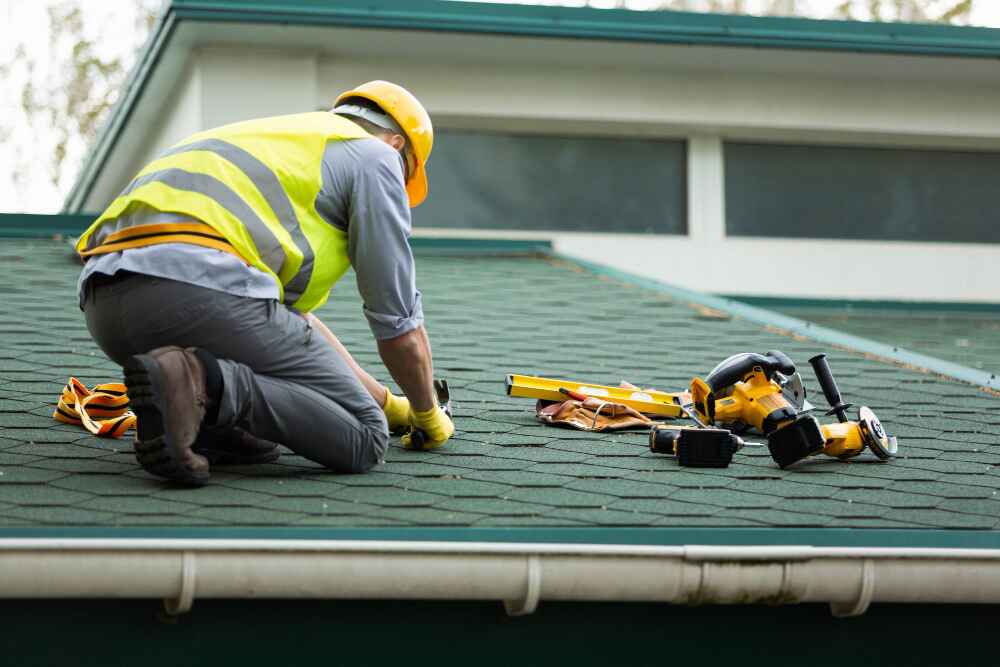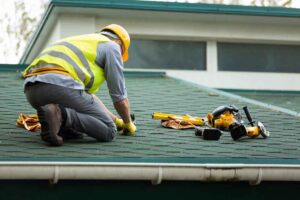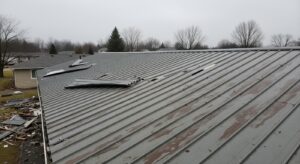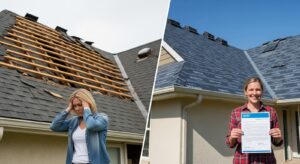Your roof silently battles the elements 365 days a year, facing scorching summer heat, pounding autumn rains, freezing winter storms, and spring’s unpredictable weather swings. Yet most homeowners only think about their roof when something goes wrong – usually at the worst possible moment, like during a midnight thunderstorm or holiday weekend.
Here’s the reality: a well-maintained roof can last 20-30 years or more, while a neglected one might need replacement in half that time. The difference? Following proper roofing maintenance tips throughout every season, not just when problems become obvious.
Whether you’re a new homeowner wondering where to start or a seasoned property owner looking to optimize your maintenance routine, this comprehensive guide will transform how you think about roof care. We’ll walk through season-specific challenges, essential safety protocols, and proven strategies that professional roofers use to extend roof life and prevent costly emergency repairs.
By the end of this guide, you’ll have a complete understanding of year-round roof maintenance that protects your investment, saves money, and gives you peace of mind regardless of what Mother Nature throws your way.
Understanding the Four Seasons of Roof Challenges
Every season brings unique threats to your roofing system, and successful maintenance requires understanding these seasonal patterns. Think of your roof as a complex ecosystem that must adapt to dramatically different conditions throughout the year – from UV radiation and thermal expansion in summer to ice formation and freeze-thaw cycles in winter.
Spring typically reveals winter’s hidden damage while introducing new challenges from increased precipitation and rapidly changing temperatures. This season serves as nature’s audit of your roof’s winter performance, often uncovering issues that developed during harsh weather but weren’t immediately apparent.
Summer subjects roofing materials to intense heat, UV radiation, and thermal stress that can cause expansion, cracking, and accelerated aging. The season also brings severe weather events like hail storms and high winds that can cause immediate damage requiring prompt attention.
Autumn presents falling debris challenges, gutter overflow issues, and the critical preparation period for winter’s harsh conditions. This season offers your last opportunity to address minor issues before they become major problems during winter’s freeze-thaw cycles.
Winter tests every aspect of your roofing system with ice, snow loads, freeze-thaw cycles, and limited accessibility for repairs. Understanding winter’s unique challenges helps you prepare appropriately and recognize when professional intervention becomes necessary.
The key insight for effective roofing maintenance tips is that prevention during one season directly impacts performance in the next. Spring preparation affects summer performance, summer maintenance prevents autumn problems, and autumn preparation is crucial for winter survival.
Spring Roofing Maintenance: Awakening Your Roof from Winter’s Grip
Spring roofing maintenance begins with comprehensive assessment and damage evaluation. Winter’s freeze-thaw cycles, ice formation, and snow loads often create problems that aren’t immediately visible, making thorough spring inspection crucial for year-long roof health.
Visual inspection from ground level should be your first step, using binoculars to examine shingle condition, flashing integrity, and overall roof structure. Look for missing or damaged shingles, sagging areas, debris accumulation, and any obvious signs of wear or damage. Pay special attention to areas around chimneys, vents, and other roof penetrations where leaks commonly develop.
Gutter system evaluation becomes critical after winter’s debris accumulation and potential ice damage. Clean gutters thoroughly, checking for proper drainage, secure attachment, and adequate slope. Inspect downspouts for blockages and ensure water flows away from your foundation effectively. Consider that clogged gutters can cause water backup that damages roofing materials and creates interior water problems.
Attic inspection reveals problems that might not be visible from outside. Look for signs of water infiltration, including stains, mold growth, or damp insulation. Check ventilation systems to ensure proper airflow, as inadequate ventilation can cause moisture problems and reduce energy efficiency throughout the year.
Professional assessment timing varies by climate and roof age, but spring often provides ideal conditions for comprehensive evaluations. Many roofing contractors offer spring inspection services that can identify potential problems before they become expensive emergencies. Consider this investment particularly valuable for roofs over ten years old or those that experienced severe winter weather.
Immediate repair priorities should focus on any damage that could allow water infiltration or worsen with continued exposure. Address loose or missing shingles, damaged flashing, and any structural concerns promptly. Remember that minor repairs in spring can prevent major problems during summer storm season.
Summer Roofing Tips: Protecting Your Roof from Heat and Storms
Summer presents unique challenges that require specific roofing tips for homeowners to navigate successfully. Extreme temperatures, intense UV radiation, and severe weather events demand proactive maintenance and careful timing of repair activities.
Heat-related maintenance becomes crucial as roofing materials expand and contract with temperature changes. Asphalt shingles become pliable in extreme heat, making them vulnerable to damage from foot traffic or debris impact. Schedule maintenance activities for early morning or evening hours when temperatures are more moderate and materials are less likely to sustain heat-related damage.
UV protection strategies help extend roofing material life significantly. Consider applying reflective coatings to appropriate roofing materials, ensure adequate attic ventilation to reduce heat buildup, and inspect seals and sealants regularly as UV exposure can cause cracking and deterioration. Light-colored roofing materials generally perform better in extreme heat, though this consideration is more relevant during replacement planning.
Storm preparation becomes essential during summer’s severe weather season. Secure loose items that could become projectiles, trim tree branches that overhang your roof, and ensure gutters and downspouts can handle heavy rainfall effectively. Consider impact-resistant roofing materials if you live in hail-prone areas, though this upgrade typically occurs during replacement rather than routine maintenance.
Ventilation optimization proves crucial for both energy efficiency and roofing material longevity. Proper attic ventilation reduces heat buildup that can cause shingle deterioration and increase cooling costs. Check that intake vents under eaves remain unblocked and exhaust vents at the ridge function properly. Adequate ventilation can reduce attic temperatures by 10-15 degrees, significantly extending roofing material life.
Emergency preparation should include identifying reliable contractors for storm damage repairs, understanding your insurance coverage for weather-related damage, and maintaining emergency supplies for temporary repairs. Having tarps, roofing cement, and basic tools readily available can prevent minor damage from becoming major problems if immediate professional help isn’t available.
Autumn Roofing Maintenance: Preparing for Winter’s Harsh Reality
Autumn roofing maintenance focuses on preparation and prevention, as this season offers your final opportunity to address issues before winter’s challenging conditions make repairs difficult or impossible.
Comprehensive cleaning becomes your top priority as falling leaves and debris can create serious problems if left unaddressed. Clean gutters thoroughly and repeatedly throughout leaf-falling season, remove debris from roof surfaces that could trap moisture or create ice dam conditions, and ensure all drainage systems function properly before freezing weather arrives.
Preventive repairs should address any issues identified during summer monitoring or autumn inspection. Replace damaged shingles, repair or replace worn flashing, seal any gaps or cracks that could allow water infiltration, and ensure all roof penetrations are properly sealed. Remember that repairs become significantly more difficult and expensive during winter months.
Winter preparation specifics vary by climate but commonly include installing heating cables in ice-prone areas, ensuring adequate attic insulation to prevent heat loss that contributes to ice dam formation, and trimming tree branches that could fall during winter storms. Consider professional consultation for homes in severe winter climates or those with complex roofing systems.
Gutter system winterization requires ensuring proper slope for drainage, securing all attachments, and considering heated gutter systems in areas prone to ice formation. Clogged or damaged gutters contribute significantly to winter roofing problems, making autumn maintenance crucial for winter performance.
Documentation practices should include photographing your roof’s condition before winter weather arrives. This documentation proves valuable for insurance purposes if storm damage occurs and helps track changes in roof condition over time. Many smartphones can timestamp and GPS-locate photos automatically, creating detailed maintenance records.
Winter Roofing Safety and Care: Navigating the Harshest Season
Winter roofing maintenance requires balancing necessary care with safety considerations, as cold temperatures, ice formation, and limited daylight create unique challenges for homeowners and professionals alike.
Safety considerations become paramount during winter maintenance activities. Ice-covered roofs present extreme slip hazards, cold temperatures affect material flexibility and tool operation, and shorter daylight hours limit safe working time. Most winter roofing activity should focus on observation and minor maintenance rather than major repairs.
Ice dam prevention proves more effective than remediation after problems develop. Ensure adequate attic insulation to prevent heat loss that melts snow unevenly, maintain proper ventilation to keep roof surfaces cold, and consider heating cables for problem areas identified in previous winters. Understanding that ice dams result from temperature differences between roof areas helps guide prevention efforts.
Snow load monitoring becomes important in areas with heavy snowfall, particularly for older structures or those with complex rooflines. While most residential roofs handle normal snow loads easily, excessive accumulation or ice formation can create structural stress. Know your roof’s design limitations and consider professional snow removal for extreme conditions.
Emergency response planning should include knowing how to safely access your roof if emergency repairs become necessary, having contact information for emergency roofing services, and understanding temporary repair techniques that can prevent catastrophic damage until permanent repairs are possible.
Interior monitoring often provides the best indication of winter roofing problems. Watch for signs of water infiltration, ice dam formation, or excessive heat loss that might indicate ventilation or insulation problems. Addressing interior symptoms quickly can often prevent exterior damage from worsening.
Essential Roofing Safety Tips for Every Season
Roofing safety tips apply year-round but require seasonal adaptation to address changing conditions and risks. Understanding and following proper safety protocols protects both homeowners and professionals while ensuring maintenance activities achieve their intended results.
Personal protective equipment remains essential regardless of season but may require modification for weather conditions. Non-slip footwear becomes crucial during wet or icy conditions, while hot summer weather demands heat protection and adequate hydration. Safety harnesses and fall protection equipment should be inspected regularly and replaced when worn or damaged.
Weather awareness significantly impacts safety considerations and work timing. Never attempt roofing work during wet, icy, or windy conditions, and avoid working on hot surfaces during extreme summer heat. Plan maintenance activities during moderate weather conditions when materials and safety equipment perform optimally.
Tool and equipment safety includes regular inspection and maintenance of ladders, ensuring proper setup and support, and using tools appropriate for current conditions. Cold weather can affect tool operation and material handling, while hot weather may make metal tools uncomfortable or dangerous to handle.
Professional consultation becomes important when conditions exceed safe DIY parameters or when work requires expertise beyond typical homeowner knowledge. Recognizing these limitations and seeking professional help when appropriate prevents accidents and ensures quality results.
Emergency procedures should be established and communicated to all household members. This includes knowing how to contact emergency services, having first aid supplies readily available, and establishing communication protocols for roof work activities.
Professional vs. DIY: Making Smart Decisions for Roof Maintenance
Understanding when to handle roofing maintenance yourself versus calling professionals saves money while ensuring safety and quality results. The decision involves evaluating task complexity, safety requirements, tool needs, and potential consequences of errors.
DIY-appropriate tasks typically include visual inspections from ground level, basic gutter cleaning, minor debris removal, and simple preventive measures like applying sealants to small problem areas. These activities require basic tools, minimal safety risks when performed properly, and offer good learning opportunities for homeowners.
Professional intervention becomes necessary for complex repairs, work on steep or high roofs, situations requiring specialized tools or materials, and any time safety risks exceed reasonable DIY parameters. Professional work often includes warranties and insurance coverage that provide additional value beyond the immediate service.
Cost considerations include both immediate expenses and long-term implications. DIY maintenance saves labor costs but requires tool investment and time commitment. Professional services cost more initially but often include expertise, warranties, and efficiency that provide long-term value. Consider that poor DIY work can create expensive problems requiring professional correction.
Skill development opportunities exist for homeowners interested in learning basic maintenance techniques. Start with simple tasks, invest in proper safety equipment, and gradually build skills and confidence. Many community colleges and home improvement stores offer classes in basic roofing maintenance techniques.
Insurance implications vary by provider and policy terms. Some insurance companies prefer professional maintenance and repairs, while others are comfortable with quality DIY work. Check with your insurance provider to understand how maintenance choices might affect coverage.
Common Roofing Problems and Seasonal Solutions
Understanding common roofing problems and their seasonal patterns helps prioritize maintenance activities and recognize when professional intervention becomes necessary. Many roofing issues develop gradually, making early detection and intervention crucial for preventing expensive damage.
Shingle deterioration occurs continuously but accelerates during specific seasons. Summer’s heat and UV exposure cause granule loss and cracking, while winter’s freeze-thaw cycles can worsen existing damage. Spring inspection often reveals winter damage, while autumn preparation can prevent winter problems from developing.
Flashing failures commonly develop around roof penetrations and are often seasonal in nature. Thermal expansion and contraction can loosen flashing attachments, while ice formation can cause physical damage. Regular inspection and timely repair prevent water infiltration that can cause extensive structural damage.
Gutter problems vary seasonally but require year-round attention. Autumn leaf accumulation causes immediate blockages, winter ice formation can damage gutter systems physically, spring runoff tests system capacity, and summer storms can overwhelm inadequate drainage.
Ventilation issues affect both energy efficiency and roofing material longevity. Poor ventilation causes heat buildup in summer and moisture problems in winter. Adequate ventilation systems require regular inspection and maintenance to function properly throughout all seasons.
Structural concerns may develop gradually but often become apparent during specific seasons. Winter snow loads can reveal structural weaknesses, while summer heat can cause expansion-related problems. Understanding your roof’s design limitations helps recognize when professional structural evaluation becomes necessary.
Technology and Tools for Modern Roof Maintenance
Modern technology offers homeowners unprecedented tools for monitoring and maintaining their roofing systems. From smartphone apps to professional-grade inspection equipment, these tools can improve maintenance effectiveness while enhancing safety and documentation.
Inspection technology includes smartphone cameras with zoom capabilities for detailed visual inspection from ground level, moisture meters for detecting water infiltration, and thermal imaging devices for identifying insulation and ventilation problems. These tools help identify problems early when they’re easier and less expensive to address.
Weather monitoring systems can provide advance warning of conditions that might damage roofing systems or create maintenance opportunities. Local weather alerts, seasonal forecasts, and real-time precipitation monitoring help plan maintenance activities and prepare for severe weather events.
Documentation systems using smartphone apps can track maintenance activities, store inspection photos with GPS and timestamp data, and maintain warranty and service records in easily accessible formats. This documentation proves valuable for insurance claims and helps track roof condition changes over time.
Professional tools used by roofing contractors include drone inspection systems, advanced moisture detection equipment, and specialized safety gear that enables more thorough and safer maintenance activities. Understanding these professional capabilities helps homeowners make informed decisions about when to seek professional services.
Emerging technologies continue to expand maintenance possibilities, including smart roofing materials that monitor their own condition, automated gutter cleaning systems, and integrated home monitoring systems that include roofing condition alerts.
Frequently Asked Questions About Seasonal Roofing Maintenance
How often should I inspect my roof throughout the year? Conduct visual inspections from ground level monthly, with more detailed assessments twice yearly in spring and fall. After severe weather events, immediate inspection helps identify damage before it worsens. Professional inspections every 2-3 years provide expert evaluation that supplements homeowner monitoring.
What are the most important roofing maintenance tips for new homeowners? Start with understanding your specific roofing system and its maintenance requirements. Establish regular inspection routines, keep gutters clean, address minor problems promptly, and develop relationships with reliable local contractors. Document your roof’s condition and maintain records of all maintenance activities.
Can I perform roof maintenance during winter months? Winter maintenance is possible but limited by safety considerations and weather conditions. Focus on interior monitoring for signs of problems, emergency response when necessary, and planning for spring maintenance activities. Most significant maintenance should wait for safer weather conditions.
What summer roofing tips are most important for preventing damage? Schedule maintenance during cooler parts of the day, ensure adequate ventilation to reduce heat buildup, prepare for severe weather events, and monitor for heat-related material changes. Summer’s intense conditions can cause rapid damage if problems aren’t addressed promptly.
How do I know when roofing maintenance requires professional help? Consider professional services for steep or high roofs, complex repairs, situations requiring specialized tools, and any time safety risks exceed your comfort level. Also seek professional help when problems exceed your knowledge or when warranties might be affected by DIY approaches.
What roofing safety tips are most important for homeowners? Never work on wet, icy, or excessively hot roofs. Use proper safety equipment including non-slip footwear and fall protection. Have someone else present when performing any roof work. Know your limitations and seek professional help when conditions or tasks exceed safe DIY parameters.
How can seasonal maintenance extend my roof’s lifespan? Regular seasonal maintenance prevents minor problems from becoming major damage, optimizes performance during challenging weather conditions, and maintains materials in good condition longer. Well-maintained roofs often last 50% longer than neglected ones while requiring fewer emergency repairs.
Building Your Year-Round Roof Maintenance Schedule
Creating a systematic approach to seasonal roof maintenance ensures nothing gets overlooked while distributing work throughout the year. A well-planned schedule prevents overwhelming seasonal rushes while maintaining optimal roof condition year-round.
Spring schedule should prioritize damage assessment from winter weather, comprehensive cleaning after debris season ends, and repair planning for summer’s favorable working conditions. This season offers ideal conditions for thorough inspection and planning activities that guide the rest of the year’s maintenance.
Summer maintenance focuses on repairs identified during spring assessment, heat-related monitoring, and storm preparation activities. Summer’s favorable weather conditions make this season ideal for major maintenance activities, though extreme heat may limit working hours to early morning or evening.
Autumn preparation concentrates on winter readiness, including comprehensive cleaning, preventive repairs, and system winterization. This season’s maintenance activities directly impact winter performance and spring condition, making autumn preparation crucial for year-round success.
Winter monitoring emphasizes safety, interior observation for problem signs, and emergency response when necessary. While active maintenance is limited during winter, careful monitoring and documentation of problem development guides spring maintenance priorities.
Documentation practices throughout all seasons create valuable records for warranty claims, insurance purposes, and long-term maintenance planning. Modern smartphone apps make documentation easy while providing GPS and timestamp data automatically.
Conclusion: Transform Your Home’s Protection with Proactive Roof Care
Mastering roofing maintenance tips for all seasons transforms one of your home’s most critical systems from a source of worry into a reliable protective asset. The difference between a roof that lasts 15 years and one that serves your family for 30 years often comes down to consistent, thoughtful maintenance that addresses each season’s unique challenges.
The strategies outlined in this comprehensive guide provide everything you need to develop an effective year-round maintenance routine. From spring’s damage assessment and repair planning to summer’s heat management and storm preparation, autumn’s winter readiness activities, and winter’s careful monitoring – each season offers specific opportunities to enhance your roof’s performance and longevity.
Remember that effective roofing tips for homeowners emphasize prevention over reaction. The small investment of time and attention throughout the year prevents the major expenses and disruptions that come with emergency repairs and premature replacement. Your proactive approach to seasonal maintenance pays dividends in extended roof life, reduced repair costs, and peace of mind during severe weather events.
The roofing safety tips integrated throughout this guide ensure your maintenance activities protect both you and your home. Never compromise safety for convenience or cost savings – the investment in proper safety equipment and professional help when needed is always worthwhile compared to the potential consequences of accidents or inadequate repairs.
Start implementing these seasonal maintenance strategies today. Begin with a thorough assessment of your roof’s current condition, create a seasonal maintenance calendar that fits your schedule and climate, and establish relationships with reliable local professionals for situations that exceed DIY capabilities. Your roof has been protecting your family faithfully – now it’s time to return that protection with the care and attention it deserves.
Take action this season, and transform your roof from a potential source of expensive surprises into a well-maintained system that provides reliable protection and adds value to your home for decades to come. Your future self – and your bank account – will thank you for the investment in proactive roof care.






